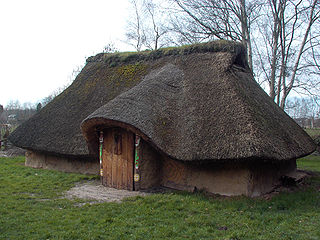Related Research Articles

The Menapii were a Belgic tribe dwelling near the North Sea, around present-day Cassel, during the Iron Age and the Roman period.

The Remi were a Belgic tribe dwelling in the Aisne, Vesle and Suippe river valleys during the Iron Age and the Roman period. Their territory roughly corresponded the modern Marne and Ardennes and parts of the Aisne and Meuse departments.

The Carnutes or Carnuti, were a Gallic tribe dwelling in an extensive territory between the Sequana (Seine) and the Liger (Loire) rivers during the Iron Age and the Roman period.
The Viducassēs were a Gallic tribe dwelling in the modern Calvados department during the Iron Age and the Roman period.

The Vellavii were a Gallic tribe dwelling around the modern city of Le Puy-en-Velay, in the region of the Auvergne, during the Iron Age and the Roman period.

The Aulerci Cenomani were a Gallic tribe dwelling in the modern Sarthe department during the Iron Age and the Roman period. The Cenomani were the most powerful of the Aulerci tribes.

The Petrocorii were a Gallic tribe dwelling in the present-day Périgord region, between the Dordogne and Vézère rivers, during the Iron Age and the Roman period.

The Bodiocasses or Baiocasses were an ancient Gallic tribe of the Roman period. They were a tribal division of the civitas of the Lexovii, in the Roman province of Gallia Lugdunensis.

The Rauraci or Raurici were a small Gallic tribe dwelling in the Upper Rhine region, around the present-day city of Basel, during the Iron Age and the Roman period.

The Parisii were a Gallic tribe that dwelt on the banks of the river Seine during the Iron Age and the Roman era. They lived on lands now occupied by the modern city of Paris, whose name is derived from the ethnonym.
The Lexovii, were a Gallic tribe dwelling immediately west of the mouth of the Seine, around present-day Lisieux, during the Iron Age and the Roman period.

The Ambiani were a Belgic coastal tribe dwelling in the modern Picardy region during the Iron Age and Roman periods.

The Diablintes or Aulerci Diablites were a Gallic tribe dwelling in the north of the modern Mayenne department during the Iron Age and the Roman period. They were part of the Aulerci.

The Redones or Riedones were a Gallic tribe dwelling in the eastern part of the Brittany peninsula during the Iron age and subsequent Roman conquest of Gaul. Their capital was at Condate, the site of modern day Rennes.
The Tricasses were a Gallic tribe dwelling on the upper Seine and the Aube rivers during the Roman period. Until the first century AD, they were probably reckoned among the Senones.

The Andecavi were a Gallic tribe dwelling in Aremorica during the Roman period.

The Gabali were a Gallic tribe dwelling in the later Gévaudan region during the Iron Age and the Roman period.

The Ruteni were a Gallic tribe dwelling in the southern part of the Massif Central, around present-day Rodez, during the Iron Age and the Roman period.

The Cadurci were a Gallic tribe dwelling in the later region of Quercy during the Iron Age and the Roman period.
The Silvanectes were a small Belgic tribe dwelling around present-day Senlis (Oise) during the Roman period.
References
- ↑ Pliny. Naturalis Historia, 4:107.
- ↑ Ptolemy. Geōgraphikḕ Hyphḗgēsis, 2:8:8.
- ↑ Notitia Dignitatum ., oc 5:116, 5:266, 7:92, 37:11, 37:22.
- ↑ Falileyev 2010, s.v. Abrincatui.
- ↑ Nègre 1990, p. 151.
- ↑ Levalet 1979, pp. 3, 15.
- ↑ Levalet 1979, pp. 14, 19.
- ↑ Levalet 1979, p. 15.
- ↑ Harry Mountain (1998), The Celtic Encyclopedia, Universal-Publishers, pp. 115–, ISBN 978-1-58112-890-1
Bibliography
- Falileyev, Alexander (2010). Dictionary of Continental Celtic Place-names: A Celtic Companion to the Barrington Atlas of the Greek and Roman World. CMCS. ISBN 978-0955718236.
- Levalet, Daniel (1979). "De la cité des Abrincates au diocèse d'Avranches. 1) L'environnement archéologique". Annales de Normandie. 29 (1): 3–22. doi:10.3406/annor.1979.5313.
- Levalet, Daniel (2011). Avranches et la cité des Abrincates (Ier siècle avant J.-C.-VIIe siècle après J.-C.) recherches historiques et archéologiques. Société des antiquaires de Normandie. ISBN 978-2-919026-03-6.
- Nègre, Ernest (1990). Toponymie générale de la France. Librairie Droz. ISBN 978-2-600-02883-7.
